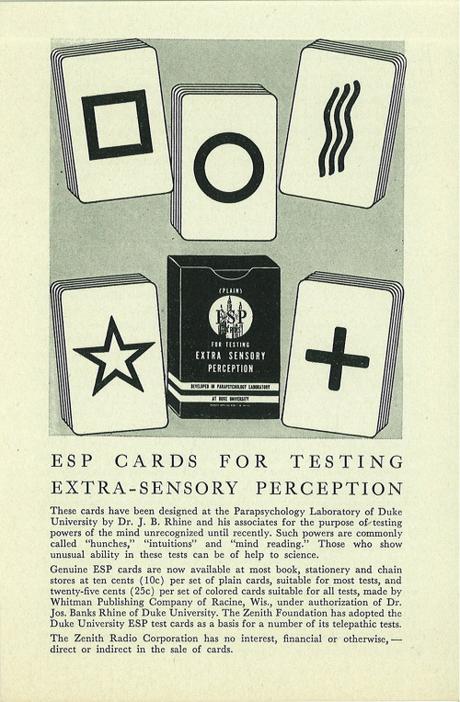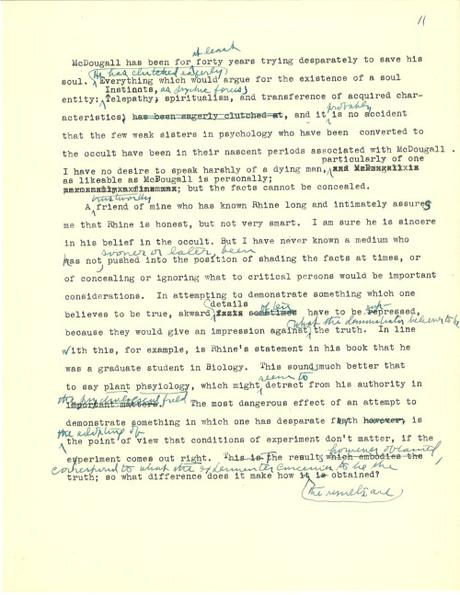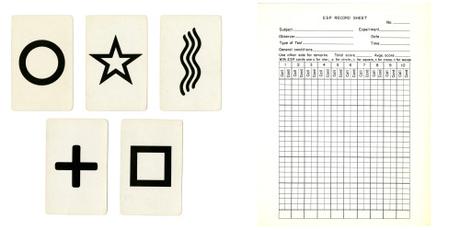– contributed by Arianna Iliff
With the seemingly endless list of paranormal reality TV shows, you’d think we’d proven the existence of the paranormal.So in the spirit (no pun intended) of Halloween, today we’ll be looking into the Duke Parapsychology Lab, a group of enterprising psychologists at Duke University in Durham, NC who attempted to do just that. In the 1930s, their research, led up by J.B. Rhine, caused a firestorm of media hype. Rhine believed that his experiments had proven the existence of extrasensory perception, or ESP.
The basic experiment was simple: in a comfortable and informal environment, an experimenter would pull from a deck of cards with one of five shapes: circle, square, star, cross, and wavy lines. He would then ask his subject to name the shape on the card without looking, and track how many matches the subject would make in a “run” of cards–that is, within a deck of 25. The cards–named for Rhine’s graduate student, Karl Zener–eventually became available publicly, so that you could test yourself for psychic powers at home!

In 1937, when this pamphlet was published, ten cents was equivalent to $1.69 in today’s money. What a bargain!
Knight Dunlap papers, box M567, folder “ESP by Rhine”
According to Rhine, the frequency with which certain subjects could match the cards was higher than mere chance. Some of the original findings of the experiment were published in the Journal of Parapsychology in 1938; however, his methods were notoriously specious, and not all psychologists were on board with this purported phenomenon. In the Knight Dunlap papers, housed here at the CCHP, there is a wealth of information about this period. Dunlap and some of his colleagues fact-checked Rhine’s flawed statistical and experimental methods, and appear to have attempted to ruin his credibility. In fact, we have a draft of one of Dunlap’s papers entitled “Occult Phenomena,” in which he bores a giant hole straight through Rhine:

“A friend of mine who has known Rhine long and intimately assures me that Rhine is honest, but not very smart.” BURN, 1938-style!
Knight Dunlap papers, box M569, folder “Occult Phenomenon”
Here’s a fun fact: one of the CCHP’s board members, Don Freedheim, attended Duke and had Karl Zener as a faculty advisor. Dr. Freedheim describes Zener as a “lovely person” who was “very supportive [and] generous with his time.” However, by this time, it wasn’t just Knight Dunlap that was critical of J.B. Rhine: according to Freedheim, by the mid-1950’s, the whole psychology department “had disavowed Rhine.” (Personal communication, 2016)
Rhine was not dissuaded easily. Over time, thousands of cycles of the card experiments were run, in varying forms with varying methods. And while the lab explored a variety of phenomena beyond just telepathy, eventually, decreasing interest and lack of funding caused the dissolution of the Duke Parapsychology Lab.
Nonetheless, Rhine insisted that one in forty people have the gift. Do you?
To read more about the Duke Parapsychology Lab, check out Unbelieveable: Investigations into Ghosts, Poltergeists, Telepathy, and Other Unseen Phenomena, from the Duke Parapsychology Laboratory by Stacy Horn–or visit us at the CCHP to see a set of Zener cards yourself!

Zener cards & ESP Record Sheet
CCHP Test Collection
